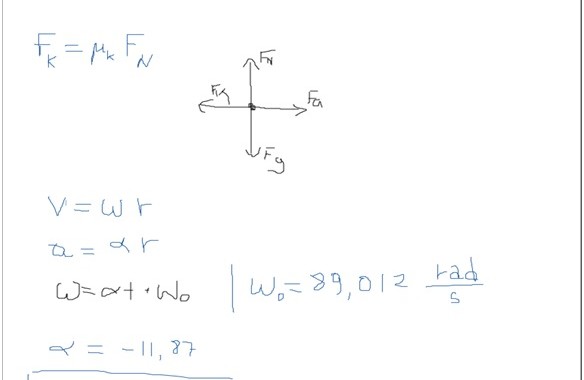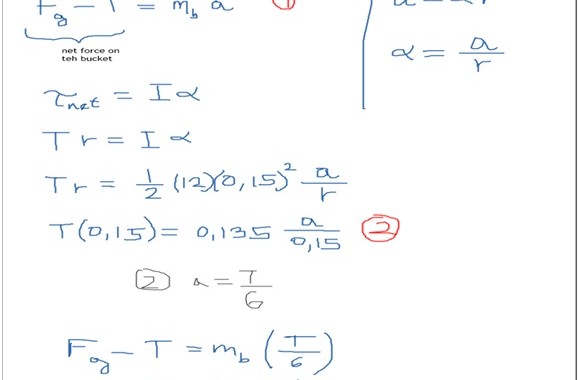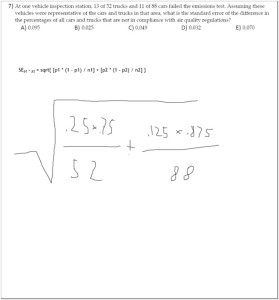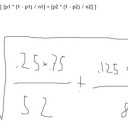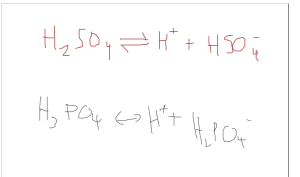Anahid nos muestra una excelente sesión de estadística, donde trataron el tema del error estándar.…
Caída libre y Tensión: Completa Tutoría de física con estudiante
Student
3. A grinding stone in the shape of a solid disk with diameter .52 m and a mass of 50 kg is rotating at 850 rev/min. You press an ax against the rim with a normal force of 160 N, And the grinding stone comes to rest in 7.5 seconds. Find the coefficient of friction. 4. A 15 kg bucket of water is suspended by a rope wrapped around a windlass, that is solid cylinder .3m in diameter with mass 12kg. The cylinder pivots on a frictionless axle through its center. The bucket is released from rest at the top of a well and falls 10m to the water. You can ignore the weight of the rope. A. What is the tension in the rope while the bucket is falling? B.With what speed does the bucket strike the water? C. What is the time of fall? D. While the bucket is falling, what is the force exerted on the cylinder by the axle?
Tutor
Hi! Welcome!!
Student
hey! its nice to meet you. I just have a couple of problem i need help on. thanks for your help!
Tutor
Nice to meet you too!!
ok
let me see problem 3 please
one sec please
Student
ok
Tutor
ok
let me draw a diagram please
Student
ok!
Tutor
ok
Can you see the diagram?
Student
yup!
Tutor
the ax exerts a normal force of Fn = 160 N
Student
yup
Tutor
ok good
Can you remember the equation for friction force??
Student
right?
Tutor
correct!!
Student
Fk=Fnx(Mue sub k)
Tutor
we need to find mu sub k
right?
Student
yup!
but we don’t know Fk so, we need to find that right?
Tutor
exactly
Student
so can i make a force diagram?
Tutor
sure
Student
right?
Tutor
we can assume the disk is horizontal
we don’t need to consider the weight Fg
ok?
Student
right. but i just put that to balance it out.
Tutor
ok
Student
would Fa= (Omega) r?
Tutor
what is Fa ?
Student
Fa= force applied
Tutor
the only force applied is Fn
Student
i dont know that force, but there must be a counter acting force, to make Fk, and also that means there must be a constant velocity or accleration
Tutor
and it makes the disk stop
We can see that the only force applied is Fn
ok?
Student
ok
Tutor
due to this force, a friction force Fk = u Fn appears
and this friction force Fk makes the disk stop
right?
Student
right
Tutor
ok
now we can find the angular acceleration of the disk
Student
alpha= (omega) r right?
Tutor
correct!!
sorry
let me change something
Student
so i get 23.143?
Tutor
V = w r
and
a = alpha r
Student
oh.
Tutor
Can you see the eqs?
V = w r
a = alpha r
Student
yup!
Tutor
ok
to find alpha we need to remember a kinematics equation
we know the initial angular speed
the time t
and the final speed
correct!!
correct!!
wf = alpha t + wo
so what is alpha?
Student
so Alpha=11.87
–
-11.87 rads/sec^2
Tutor
what is the unit?
it is better to work with rad/s
for angular speed
ok?
Student
ok
oh my bad, yeah thats what i got for Wo
Tutor
perfect!!
Student
then i divided it by time
to get my alpha
Tutor
alpha = -11.87 rad/s^2
Student
yes, that is what i got!
Tutor
good
now
we need to remember the Newton’s second law for rotations
for linear motion we know Fnet = ma
right?
Student
yup!
Tutor
and for rotations we have a very similar expression
Torque(net) = I alpha
let me write it on the board please
Can you see the eq on the board?
Student
yes
Tutor
is this expression familiar to you?
Tnet = net torque
I = moment of inertia
alpha = angular acceleration
Student
right
Tutor
ok good
what is I for a solid disk?
Student
um. 1/2MR^2?
Tutor
perfect!!!!
so let’s find I for the grinding stone
I = ?
Student
1.69?
Tutor
yes!!
I = kg m^2
Student
then i get a torque of -20.1?
Tutor
yes!!
Tnet = 20.06 N m
Can you remember the definition for torque?
the torque applied on the disk is produced by the friction force
right?
Student
uh yeah it makes sense, since the torque goes against omega
Tutor
yes!!
and torque = F d
right?
let me write it on the board
please
Student
oh right, yeah that makes sense
Tutor
ok good
so we have the eq in magnitude
Student
so Mu sub k =.483?
Tutor
20.06 Nm = u Fn (0.26)
yes!!
0.48
Great job on that one! Nicely done.
Do you have any questions about what we just did?
Student
no, i think you explained it well enough, i believe i understand the problems a lot better, thank you!
Tutor
you are welcome
now problem 4
Can you give me a moment while I take a look at problem 4??
Student
ok
Tutor
ok
let me draw a diagram please
on a new board
Student
k
Tutor
ok can you see the diagram?
Student
yup!
Tutor
ok good
what forces are acting on the bucket?
Student
gravity, and the rope?
Tutor
good
gravity and tension
ok
for part A we have to find the tension
right?
Student
yup
so Ft=Mbg?
so Ft=147N?
Tutor
Fg = mb g
Fg = 15 kg x 9.8 m/s^2
Fg = 147 N
right?
Student
oh right
Tutor
but it is not T
the bucket is falling
with a certain acceleration a
right?
Student
yes
Tutor
and for the bucket we have Fnet = m a
or
Fg – T = mb a
right?
Student
yes
that makes sense
Tutor
ok
a is the acceleration of the bucket
and it is also the tangential acceleration of teh cylinder
right?
do you agree??
Student
yes, that would make sense
Tutor
ok
let me write one more eq please
on the white board
Student
k
Tutor
what is the moment of inertia of a solid cylinder?
Student
i believe the same as the disk problem
Tutor
good
1/2 m r^2
Student
so .135 Alpha= Tr
Tutor
ok good
and alpha = a/r
right?
Student
right
Tutor
ok good
I labeled equations 1 and 2
can you see it??
Student
yup
Tutor
we can take these two eqs
and form a system of equations
right?
Student
yup
Tutor
we have two eqs
and two unknown
variables
a and T
Student
so should we plug in for T or a?
Tutor
we need both
Student
i think a right?
Tutor
yes
any is ok
Student
so i simplified it. and got a=T/6
is that right?>
Tutor
perfect!!
now let’s replace a in eq 1
Student
so i get T=42?
Tutor
perefct!!
T = 42 N
good
is it clear so far?
Student
yeah, things are clearing up, thanks a bunch!
Tutor
note that we are using the same equations we used in the previous problem
Tnet = I alpha
T = F d
and
a = alpha r
right?
Student
yeah!
Tutor
and the Newton’s second law
Fnet = ma
ok good
let’s see part B
B. With what speed does the bucket strike the water?
we can find a now
right?
what is a?
Student
7m/s^2
Tutor
yes a= 7 m/s^2
now we have a kinematics problem
the bucket starts from rest
and falls 10 m
what is the final velocity?
let me see
perfect!!
Vf = 11.83 m/s
Student
and that means the time to hit the water is 1.69?
Tutor
yes!!
t = 1.69 s
Student
ok part D. this one is more complicated
would it be 147N?
Tutor
it would be the same magnitude as tension
right?
the cylinder is rotating
but it is in translational equilibrium
Student
so it would not be 42N?
Tutor
T = 42 N
Student
right. but that wouldnt be the force on the cylinder?
Tutor
yes
it would be the force on teh cylinder applied by the axle
Student
ok so how do we find this force?
Tutor
let me draw a diagram please
Can you see the diagram?
the force F is exerted by teh axle
on the cylinder
right?
Student
yeah that makes sense
Tutor
the cylinder is in translational equilibrium
so the equilibrium conditions must be verified
Sum Fx = 0
Sum Fy =0
Sum Fy = F – T = 0
right?
Student
right that makes sense
and there is no force in the X direction right?
Tutor
exactly
so F = T
Student
so F=42?
Tutor
good
Student
so it is 42?
Tutor
exactly
You got it!
Student
haha. thanks.
Tutor
Do you have any questions about what we just did?
Student
no i think i got the jist of it. thank you so much!
Tutor
you are welcome
Thanks.
Student
have a good day!
Colaborador: Luis Rodríguez, Tutor Boliviano de Física

